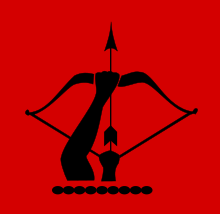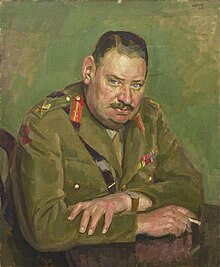| Anti-Aircraft Command | |
|---|---|
 | |
| Active | 1 April 1939 – 10 March 1955 |
| Country | |
| Branch | |
| Type | Command |
| Role | Ground Based Air Defence |
| Garrison/HQ | Bentley Priory |
| Engagements | Battle of Britain The Blitz Baedeker Raids Baby Blitz Operation Diver |
| Commanders | |
| Notable commanders | Lt-Gen Alan Brooke Lt-Gen Sir Frederick Pile |
Anti-Aircraft Command (AA Command, or "Ack-Ack Command") was a British Army command of the Second World War that controlled the Territorial Army anti-aircraft artillery and searchlight formations and units defending the United Kingdom.
Origin

The formation of a Command-level body of anti-aircraft defences had been announced in 1938, but Anti-Aircraft Command was not formed until 1 April 1939 under General Sir Alan Brooke, who had been commander of Anti-Aircraft Corps. He then passed control to Sir Frederick Pile, who remained in command until the end of the war.
AA Command was under the operational direction of RAF Fighter Command as part of Air Defence of Great Britain, and occupied a headquarters known as Glenthorn in the grounds of Bentley Priory, home of Fighter Command.
The majority of AA Command's guns and searchlights were operated by Territorial Army units. Some Regular Army units joined after they returned from the Dunkirk evacuation. Later, as the war progressed, Regulars and TA were freed up for overseas service by the use of men of the Home Guard (loading and firing the guns) and women of the Auxiliary Territorial Service (handling ammunition and operating gun directors).
Organisation
Divisional

Divisions under the command were:
- 1st Anti-Aircraft Division – Existing division at start of the war, headquartered in Uxbridge.
- 2nd Anti-Aircraft Division – Existing division at the start of the war, headquartered at RAF Hucknall, Nottinghamshire.
- 3rd Anti-Aircraft Division – Existing division at the start of the war, headquartered in Edinburgh.
- 4th Anti-Aircraft Division – Existing division at the start of the war, headquartered in Chester.
- 5th Anti-Aircraft Division – Existing division at the start of the war, headquartered in Reading.
- 6th Anti-Aircraft Division – Existing division at the start of the war, headquartered in Uxbridge.
- 7th Anti-Aircraft Division – Existing division at the start of the war, headquartered in Newcastle upon Tyne.
- 8th Anti-Aircraft Division – Formed November 1940 covering South West England, headquartered in Bristol.
- 9th Anti-Aircraft Division – Formed November 1940 covering South Wales, headquartered in Cardiff.
- 10th Anti-Aircraft Division – Formed November 1940 covering Yorkshire and the Humber Estuary.
- 11th Anti-Aircraft Division – Formed November 1940 covering the West and Central Midlands.
- 12th Anti-Aircraft Division – Formed November 1940 covering southwestern Scotland.
AA Command was also responsible for the Orkney and Shetland Defences (OSDEF).
Corps
At the end of 1940, the Command created three Corps to supervise this expanding organisation:
- I Anti-Aircraft Corps covering the South (1, 5, 6, 8 and 9 AA Divisions) corresponding with 10 and 11 Groups RAF
- II Anti-Aircraft Corps covering the Midlands (2, 4, 10 and 11 AA Divisions) corresponding with 9 and 12 Groups RAF
- III Anti-Aircraft Corps covering the North (3, 7 and 12 AA Divisions, and OSDEF) corresponding with 13 and 14 Groups RAF
Groups
In October 1942, the corps and divisions were abolished and replaced by seven flexible AA Groups more closely aligned with the operational structure of Fighter Command:
- 1st Anti-Aircraft Group covering London
- 2nd Anti-Aircraft Group covering the Solent, South-East England and southern East Anglia
(1st and 2nd AA Groups coincided with No. 11 Group RAF)
- 3rd Anti-Aircraft Group covering South-West England and South Wales (coinciding with No. 10 Group RAF)
- 4th Anti-Aircraft Group covering North Wales and North-West England (coinciding with No. 9 Group RAF)
- 5th Anti-Aircraft Group covering northern East Anglia and the East Coast as far as Scarborough, North Yorkshire (coinciding with No. 12 Group RAF)
- 6th Anti-Aircraft Group covering North-East England and Scotland (coinciding with No. 13 Group RAF (except Northern Ireland) and No. 14 Group RAF)
- 7th Anti-Aircraft Group covering Northern Ireland
- the Orkney and Shetland Defences remained separate
Later events

Later, the 6th AA Group took over the Solent area to cover the preparations for Operation Overlord and was replaced in NE England by a new 8th Anti-Aircraft Group.
A new 9th Anti-Aircraft Group was formed to cover southern East Anglia during the flying bomb offensive (Operation Diver).
On 1 April 1943, AA Command took over control of smoke screens from the Ministry of Home Security. These installations were manned by the Pioneer Corps.
In November 1944, the 3rd, 4th and 7th Anti-Aircraft Groups were disbanded, with the areas covered by the 2nd and 5th Anti-Aircraft Groups extended.
Postwar
When the TA was reformed after the Second World War in 1947, AA Command was generously provided for, with a large number of units, some of them including members of the Women's Royal Army Corps (successors of the ATS). It was structured in five regional AA Groups, each commanding a number of TA and Regular AA Brigades:
- 1st AA Group – London
- 2nd AA Group – Aldershot
- 3rd AA Group – Edinburgh
- 4th AA Group – Warrington
- 5th AA Group – Nottingham
On 1 December 1954, it was announced that AA Command would be disbanded with effect from 10 March 1955.
Senior staff
The following officers held senior posts in AA Command:
General Officers Commanding-in-Chief
- Lieutenant-General Alan Brooke (1 April – 28 July 1939; GOC AA Corps 15 July 1938 – 31 March 1939)
- Lieutenant-General Sir Frederick Pile (12 October 1939 – 14 April 1945)
- Lieutenant-General Sir William Green (15 April 1945 – 30 April 1946)
- Lieutenant-General Otto Lund (1 May 1946 – May 1948)
- Lieutenant-General Sir Ivor Thomas (May 1948 – 27 May 1950)
- Lieutenant-General Charles Loewen (28 May 1950 – 16 April 1953)
- Lieutenant-General Sir Maurice Chilton (17 April 1953 – 15 May 1955)
Major-General, General Staff

- Major-General Thomas Newton (8 May 1939 – 31 December 1941)
- Major-General Robert Whittaker (1 January 1942 – 21 February 1944
- Major-General Frank Lejeune (22 February 1944 – 22 May 1944)
- Major-General Stephen Lamplugh (19 June 1944 – 24 June 1945)
Brigadier, General Staff
- Brigadier B. P. Hughes (1 October 1942 – 1943)
- Brigadier Stephen Lamplugh (25 June 1945 – 30 July 1946)
- Brigadier Geoffrey Thompson (1 July 1946 – 31 December 1946)
Chief of Staff
- Brigadier Geoffrey Thompson (1 January 1947 – April 1948)
Deputy Director, Auxiliary Territorial Service
- Controller V. P. Farrow (12 May – 14 October 1942)
- Controller The Hon. Lady M. Lawrence (15 October 1942 – 27 June 1943)
- Senior Controller Christian Fraser-Tytler (28 June 1943 – 1944/45)
See also
- Balloon Command
- Bomber Command
- Fighter Command
- 7th Air Defence Group – current successor organisation to AA Command
- Army Air Defense Command (United States) - successive US organizations, named Army Antiaircraft Command 1950–1957
Notes
- ^ Routledge, Chapter 26.
- ^ Robert Palmer, 'A Concise History of Anti-Aircraft Command (History & Personnel)' at British Military History.
- Farndale, p. 5.
- Wykeham
- ^ Sir Frederick Pile's despatch.
- AA Command Orbat 3 September 1939 at Patriot Files
- ^ "RA 39–45 UK 1940". Ra39-45.co.uk.
- Farndale, Annex D.
- Routledge, Chapter 28.
- "RA 39–45 1 AA Corps". Ra39-45.co.uk.
- "RA 39–45 2 AA Corps". Ra39-45.co.uk.
- "RA 39–45 3 AA Corps". Ra39-45.co.uk.
- Routledge, Chapter 29.
- Routledge, p. 409.
- Routledge, p. 417.
- Litchfield, pp. 332–5.
- Routledge, p. 430.
- Watson, TA 1947.
- Routledge, p. 439.
- Beckett, p. 178.
- Farndale, Annex J.
- Brooke at Generals of World War II
- Pile at Generals of World War II
- Green at Generals of World War II
- Lund at Generals of World War II
- Thomas at Generals of World War II
- Loewen at Generals of World War II
- Chilton at Generals of World War II
- Newton at Generals of World War II
- Whittaker at Generals of World War II
- Lejeune at Generals of World War II
- Lamplugh at Generals of World War II
- Hughes at Generals of World War II
- Thompson at Generals of World War II
References
- I. F. W. Beckett, Territorials: A Century of Service, TA100, 2008.
- Gen Sir Martin Farndale, History of the Royal Regiment of Artillery: The Years of Defeat: Europe and North Africa, 1939–1941, Woolwich: Royal Artillery Institution, 1988/London: Brasseys, 1996, ISBN 1-85753-080-2.
- Norman E. H. Litchfield, The Territorial Artillery 1908–1988 (Their Lineage, Uniforms and Badges), Nottingham: Sherwood Press, 1992, ISBN 0-9508205-2-0.
- Sir Frederick Pile's despatch: 'The Anti-Aircraft Defence of the United Kingdom from 28 July 1939, to 15 April 1945' London Gazette 18 December 1947.
- Brig N. W. Routledge, History of the Royal Regiment of Artillery: Anti-Aircraft Artillery 1914–55, London: Royal Artillery Institution/Brassey's, 1994, ISBN 1-85753-099-3.
- Peter Wykeham, Fighter Command: A Study of Air Defence, 1914–1960, accessed 30 May 2008.
External links
- British Military History
- Generals of World War II
- Orders of Battle at Patriot Files
- Royal Artillery 1939–1945
- Regiments.org Land Forces of Britain, the Empire and Commonwealth
- Graham Watson, The Territorial Army 1947
| The Blitz | |
|---|---|
| Towns and Cities | |
| Related topics | |
| Organisations | |
| Air Defence of Great Britain during the Second World War | |||||||||||
|---|---|---|---|---|---|---|---|---|---|---|---|
| Overview | |||||||||||
| People |
| ||||||||||
| Organisation |
| ||||||||||
| Campaigns and operations | |||||||||||
| Aircraft | |||||||||||
| Technology | |||||||||||
| Related topics | |||||||||||
| British army groups, armies, commands, and corps during the Second World War | |
|---|---|
| Army Groups (list) | |
| Armies (list) | |
| Corps (list) | |
| Commands (list) |
|
| Other | |